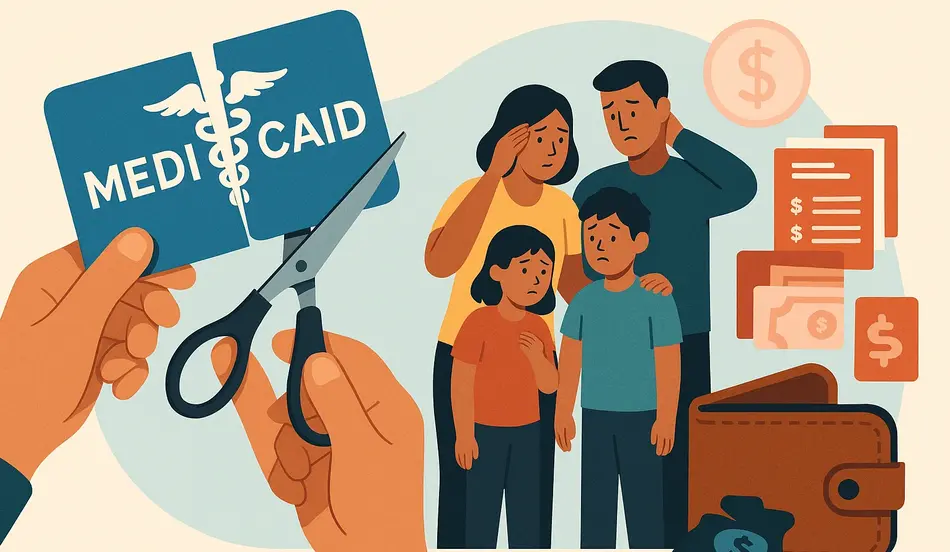The Looming Healthcare Crisis: Understanding the Impact of Federal Medicaid Cuts
The American healthcare system is facing a critical turning point as significant federal Medicaid funding cuts threaten to create ripple effects across the entire healthcare landscape. These cuts are poised to impact not just Medicaid recipients but every American who purchases health insurance, regardless of their coverage source.
Colorado Governor Jared Polis highlighted the severity of this situation, stating: “When you have more people without insurance, the costs get shifted since they don’t have a payer on to people with insurance. And so, like every other state, we’re going to be wrestling with everyday customers who get their insurance from their work, who buy it on their own, having to pay a lot more next year. And that’s bad news for Americans.”
This impending crisis represents a perfect storm of healthcare challenges: reduced federal funding, increased state budget pressures, potential hospital closures, and ultimately higher insurance premiums for all Americans.
The Financial Impact on State Budgets: A $500 Million Problem
Budget Shortfalls Across the Political Spectrum
The Medicaid cuts are creating unprecedented budget challenges for states regardless of political affiliation. Colorado alone is projecting approximately $500 million less in revenue, coupled with an additional $500 million in increased costs for healthcare and food assistance programs. This billion-dollar gap represents a significant fiscal challenge that cannot be easily addressed.
Governor Polis emphasized the bipartisan nature of this crisis: “This is affecting red states, blue states. It doesn’t matter fundamentally. Medicaid, which has been funded federally with the state match, is being cut back.”
Unlike the federal government, states must maintain balanced budgets, making these cuts particularly challenging to absorb. As Polis noted, “States have to do that. We do that in Colorado. Every state does that. We can’t just do deficit spending like the federal government.”
The Hidden Costs Beyond Budget Lines
Beyond the immediate budget impacts, these cuts create cascading effects throughout state economies:
- Increased uncompensated care costs for hospitals and healthcare providers
- Reduced healthcare access in vulnerable communities
- Potential job losses in the healthcare sector
- Economic impacts from reduced healthcare spending in local economies
- Administrative costs of processing Medicaid disenrollments
The Human Cost: Hundreds of Thousands Losing Healthcare Coverage
Coverage Losses Across America
The most immediate and devastating impact of these Medicaid cuts will be felt by those who lose their healthcare coverage entirely. Governor Polis was blunt about the scale of this problem: “It means hundreds of thousands of Coloradans will lose their health care coverage they have today.”
This pattern is repeating across the country, with some states facing even more severe impacts:
- In Tennessee, approximately 20% of SNAP (Supplemental Nutrition Assistance Program) recipients are projected to lose benefits
- Many southern states have higher percentages of residents on Medicaid and will experience proportionally larger funding losses
- Rural and low-income communities will be disproportionately affected
The Life-or-Death Consequences
The governor highlighted that these cuts go far beyond financial considerations: “The tragic human face of this for anybody who’s lost somebody in their family before their time, they know that that can weigh on people even more than the dollars and cents.”
Research consistently shows that lack of health insurance leads to:
- Delayed or foregone preventive care
- Later-stage diagnosis of serious conditions
- Reduced management of chronic diseases
- Higher mortality rates from treatable conditions
- Increased financial bankruptcies due to medical bills
The Rural Healthcare Crisis: Community Hospitals on the Brink
Rural Hospital Closures Looming
One of the most concerning aspects of the Medicaid cuts is their potential impact on rural healthcare infrastructure. Rural hospitals, many of which are already financially vulnerable, rely heavily on Medicaid reimbursements to remain operational.
Governor Polis painted a grim picture of the situation: “Many of these rural hospitals have been barely viable, barely able to hold their ground as it is. Losing a lot of their payers will simply render them unable to be run on an ongoing basis.”
The Domino Effect of Hospital Closures
When rural hospitals close, the impacts extend far beyond just healthcare access:
- Increased travel distances for emergency and routine care
- Longer ambulance transport times in life-threatening situations
- Loss of local jobs and economic activity
- Reduced ability to attract businesses and residents to rural areas
- Disproportionate impact on elderly and disabled populations who face mobility challenges
“I think you’re going to see across the entire country a number of rural providers going out of business and folding up, which means that people will have to travel even further to get the care they need,” Polis warned.
The Cost-Shifting Reality: Why Everyone’s Premiums Will Rise
Understanding Healthcare Cost Shifting
Perhaps the most insidious aspect of Medicaid cuts is how they affect even those who aren’t on Medicaid. When people lose insurance coverage, they don’t stop needing healthcare—they simply lose the ability to pay for it through insurance.
Governor Polis explained this fundamental healthcare economics principle: “When you have more people without insurance, the costs get shifted since they don’t have a payer on to people with insurance.”
The Premium Increase Cycle
This cost-shifting creates a vicious cycle:
- Medicaid cuts lead to more uninsured individuals
- Uninsured individuals still require healthcare, often through emergency rooms
- Hospitals and providers must recoup these uncompensated care costs
- These costs are shifted to those with insurance through higher rates
- Higher insurance rates make coverage less affordable for more people
- More people become uninsured, continuing the cycle
“We’re going to be wrestling with everyday customers who get their insurance from their work, who buy it on their own, having to pay a lot more next year,” Polis predicted.
The Political Dimension: Bipartisan Problem, Partisan Response
The Silence from Red State Governors
Despite the fact that many Republican-led states will be disproportionately affected by these cuts, there has been a notable lack of public opposition from their governors.
When asked about this discrepancy, Governor Polis observed: “Republican governors are hesitant to criticize this president, whether it’s out of fear or out of affinity, you’d have to ask them. Certainly, they’re dealing with the same real-life issues.”
The Disproportionate Impact on Conservative States
The irony of the situation is that many conservative states have higher percentages of residents on Medicaid and other federal assistance programs:
- States like Mississippi, Alabama, and Kentucky have some of the highest Medicaid enrollment rates
- Rural areas, which tend to vote more conservative, are more dependent on Medicaid for healthcare access
- Many red states did not expand Medicaid under the Affordable Care Act, making their systems more vulnerable to cuts
As Polis noted: “Those governors and their budget folks are very worried, whether they say it publicly or not. They’re losing a higher amount pro rata than even our state is.”
State-Level Solutions: Limited Options in a Federal Crisis
What States Can and Cannot Do
States are scrambling to address these funding gaps, but their options are inherently limited:
- Increase state taxes to offset federal cuts (politically challenging)
- Reduce eligibility or benefits for state programs (harms vulnerable populations)
- Cut other state services to preserve healthcare funding (creates new problems)
- Implement more efficient healthcare delivery models (takes time and investment)
“States are going to do what we can, but there’s no theoretical way” to fully replace the lost federal funding, Governor Polis acknowledged.
Innovation Under Pressure
Some states are exploring creative approaches to mitigate the damage:
- Telehealth expansion to reduce costs while maintaining access
- Community health worker programs to provide preventive care
- Public-private partnerships to support rural healthcare
- Prescription drug cost control measures
- Healthcare workforce development initiatives
Looking for Healthcare Career Stability in Uncertain Times?
Despite these challenges, the healthcare sector continues to need qualified professionals who can help navigate this complex landscape. If you’re interested in healthcare careers that remain in demand even during funding fluctuations, WhatJobs offers numerous opportunities across the healthcare spectrum.
- Explore positions in healthcare administration to help facilities manage tighter budgets
- Find nursing and direct care roles that remain essential regardless of funding changes
- Discover healthcare policy and advocacy positions working to improve the system
- Investigate telehealth and healthcare technology jobs that are transforming care delivery
Search Healthcare Jobs on WhatJobs Today →
Struggling with Medicaid Staffing Challenges?
Medicaid changes are here—don’t face them unprepared. Find the professionals who can help your healthcare organization thrive through transition:
- Financial experts who understand healthcare reimbursement
- Admin staff skilled in Medicaid eligibility and enrollment
- Clinical professionals trained in cost-efficient patient care
- Healthcare IT specialists ready to streamline your systems
FAQ: Understanding Medicaid Cuts and Their Impact
How will Medicaid cuts affect people who don’t receive Medicaid benefits?
Medicaid cuts will impact everyone through a process called “cost-shifting.” When people lose Medicaid coverage, they don’t stop needing healthcare—they simply lose the ability to pay for it. Healthcare providers must recoup these costs by charging higher rates to those with insurance, leading to premium increases for everyone. As Governor Polis explained, “When you have more people without insurance, the costs get shifted since they don’t have a payer on to people with insurance,” resulting in higher rates for all Americans, regardless of their insurance source.
Will Medicaid cuts lead to rural hospital closures?
Yes, Medicaid cuts significantly increase the risk of rural hospital closures. Many rural hospitals operate on razor-thin margins and rely heavily on Medicaid reimbursements to remain viable. Governor Polis warned that “many of these rural hospitals have been barely viable, barely able to hold their ground as it is. Losing a lot of their payers will simply render them unable to be run on an ongoing basis.” These closures would force rural residents to travel much farther for healthcare, creating dangerous delays in emergency situations and reducing access to routine care.
How are state budgets affected by federal Medicaid cuts?
State budgets face severe strain from Medicaid cuts, creating dual financial pressures: reduced federal revenue and increased healthcare costs. For example, Colorado projects approximately $500 million less in revenue coupled with an additional $500 million in increased costs for healthcare and food assistance programs. Unlike the federal government, states must maintain balanced budgets, forcing difficult choices between raising taxes, cutting services, or reducing healthcare benefits. As Governor Polis noted, “States have to do that. We do that in Colorado. Every state does that. We can’t just do deficit spending.”
Which states will be most affected by Medicaid funding reductions?
While all states will feel the impact of Medicaid cuts, many Republican-led states will paradoxically experience more severe effects despite less vocal opposition from their leadership. As Governor Polis observed, “Generally speaking, many of the redder states have a higher percentage of people on Medicaid and will lose even more funding pro rata than states like California, New York, Colorado.” States with higher poverty rates, more rural populations, and those that didn’t expand Medicaid under the Affordable Care Act may face particularly acute challenges as federal support diminishes.
What are the long-term health consequences of reducing Medicaid coverage?
The long-term health consequences of reducing Medicaid coverage extend beyond immediate financial concerns to include serious public health impacts. When people lose insurance, they often delay or forego preventive care, leading to later diagnoses of serious conditions and poorer management of chronic diseases. Governor Polis highlighted the human cost: “The tragic human face of this for anybody who’s lost somebody in their family before their time, they know that that can weigh on people even more than the dollars and cents.” Research consistently shows that lack of health insurance correlates with higher mortality rates from treatable conditions.




